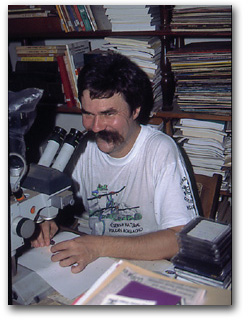|
COLLECTING
TRIP TO
HONDURAS, NICARAGUA, AND EL SALVADOR
October, 1999
|
| |
From
10-20 October 1999, Brett Ratcliffe and Federico Ocampo went
to Honduras, Nicaragua, and El Salvador to conduct research,
identify and curate collections, and collect for the project
"Faunistic Survey of the Dynastine Scarab Beetles of
Honduras, Nicaragua, and El Salvador". |
| |
| |
The
study area: Honduras, Nicaragua, and El Salvador.
|
| |
| |
|
|
|
| Co-PIs
Brett Ratcliffe (left) and Ronald Cave at the insect collection
of the Escuela Agrícola Panamericana in Zamorano, Honduras.
Photo by Federico Ocampo.
.
|
........ |
Male
minor of Golofa pizarro Hope. This is a large species
that lives from Mexico to Nicaragua. The specimen was collected
at Cerro Apalya, Honduras, at 1400 m altitude during a cold,
misting rain. Photo by Federico Ocampo. |
| |
| |
Most
dynastine scarab beetles are nocturnal and are attracted to
lights, so using light traps is the best way to collect them.
We also use flight intercept traps, fruit baits, foliage gleaning,
and searching in logs and stumps. |
|
|
|
Federico
Ocampo and Ronald Cave collecting at Cerro Apalaya in Honduras.
Photo by Brett Ratcliffe. |
........ |
Megasoma
elephas. The Elephant Beetle.
Photo by Federico Ocampo.
. |
| |
| |
The
Museo de Historia Natural de El Salvador is an old building
that is now being reconditioned. It is located in a forested
city park that used to be a coffee plantation. At the museum
we presented a workshop on how to identify dynastines to people
from several agencies that are collaborating with the project.
Also at the museum we organized and identified the collection. |
| |
|
|
|
The
main building (currently being renovated) of the Museo de
Historia Natural de El Salvador in San Salvador. This was
originally the home of the Japanese owner of the coffee plantation.
Photo by Brett Ratcliffe. |
........ |
Volcán
Izalco, El Salvador. Photo taken from adjacent Cerro Verde.
Photo by Federico Ocampo.
.
. |
| |
| |
| In
El Salvador we collected at Cerro Verde. This mountain is about
2,000 meters high. At that altitude we were collecting in cloud
forest. The natural vegetation has been less disrupted, and
so the diversity of insects and other animals is higher. In
the lowlands the natural forest has been cleared for coffee
plantations, sugar cane, and other crops. The higher areas of
the mountains and volcanoes are now refuges of biodiversity,
but these areas are becoming more and more isolated because
of continuing deforestation. |
|
|
|
Eunice
Echeverría, director of the Museo de Historia Natural
de El Salvador and principal collaborator in El Salvador for
the survey. Photo by Federico Ocampo. |
........ |
Federico
Ocampo with a small specimen of Megasoma elephas (Fabricius).
Photo by Brett Ratcliffe.
. |
| |
| |
In
Nicaragua, we collaborated with Jean-Michel Maes, curator
of the Museo Entomológico. We also curated the collection
at the Universidad Nacional Autónoma de Nicaragua.
Our team and Jean-Michel conducted a brief collecting excursion
to Volcán Chonco where we worked in a tropical dry
forest. |
|
|
|
| Jean-Michel
Maes in his lab at the Museo Entomológico in León.
Jean-Michel, a lucanid specialist, is the collaborator for
the project in Nicaragua. Photo by Federico Ocampo. |
........ |
Megasoma
elephas anticipating the onset of rain at Zamorano, Honduras.
Photo by Federico Ocampo.
. |












